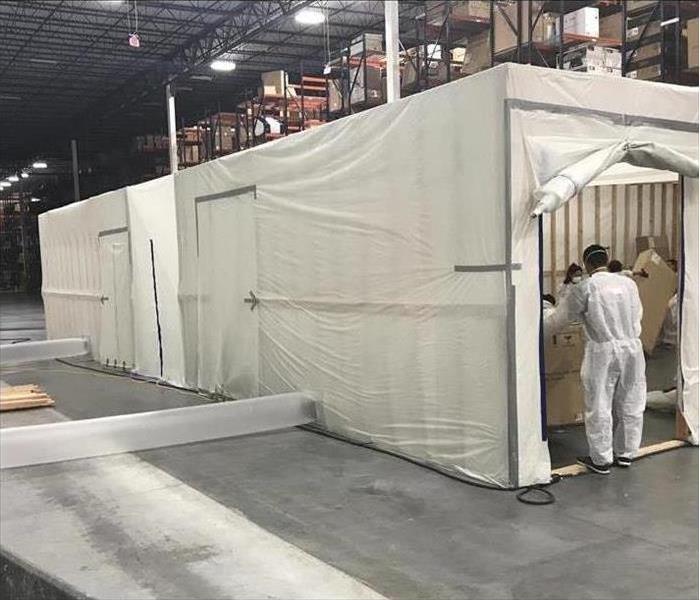SERVPRO is here to help with mold remediation for all types of New Jersey businesses
11/4/2020 (Permalink)
 When excessive moisture accumulates in buildings or on building materials, mold growth will often occur, particularly if the moisture problem remains.
When excessive moisture accumulates in buildings or on building materials, mold growth will often occur, particularly if the moisture problem remains.
Mold colonization in commercial facilities and warehouses can quickly get out of control without the appropriate intervention, SERVPRO is here to help with mold remediation for all types of Middlesex County commercial facilities.
Commercial flooding and other water damage most often have far reaching consequences on commercial property, leaving the need for many different types of property damage restoration services including water removal, demolition, deodorization and decontamination, drying and dehumidifying and rebuilding. Whether your property just weathered a season of heavy rain, experienced a common appliance malfunction or plumbing leak, commercial water damage cleanup and restoration can be complicated. It most often requires a detailed set of steps to make sure the water is properly extracted, cleaned up, dried and mitigated, when these steps aren’t taken, and moisture continues to plaque your business you could end up with a mold infestation and the need for professional mold remediation. Any commercial property can quickly become infested with mold if a source of water is present, the key to preventing excessive mold growth is to control moisture. Mold grows quickly and can spread throughout a property in as little as 24-48 hours. That’s why it’s important to act quickly if your commercial property experiences a water damage or you see any signs of hidden water or visible mold within your commercial facility. SERVPRO is a leading provider of mold remediation services across the country, our mold certified technicians can assess your commercial warehouse or building to evaluate the extent of your damage and advise owners and managers of the proper steps to remediate and restore your facility, “Like it never even happened.”
How Does Mold Damage Your Commercial Warehouse or Building?
Mold is a microscopic, airborne fungus that exists all around us, it occurs naturally in our surroundings and mostly reproduces by releasing spores into the environment. In nature, mold plays an important role in the decomposition of organic material. Mold requires both organic material and a consistent source of moisture to grow. Many materials in homes and business contain the organic materials conducive to mold growth. When excessive moisture accumulates indoors, drywall, wood, paneling, ceiling tiles, carpeting, insulation, paper, cardboard, fabric, upholstery and even paint will encourage mold growth. If there is a consistent water source, mold will continue to colonize and break down organic material into a dusty, dirt-like material. Leaving mold damage unattended to for an extended period can cause unnecessary damage to your home and possible health effects to the occupants. It’s never too early nor too late to address commercial property mold damage.
When excessive moisture accumulates in buildings or on building materials, mold growth will often occur, particularly if the moisture problem remains undiscovered or unaddressed. It is impossible to eliminate all mold and mold spores in the indoor environment. However, mold growth can be controlled indoors by controlling moisture indoors.
The Environmental Protection Agency (EPA) recommends these tips to prevent commercial property mold damage
Ensure all leaky plumbing is fixed; Correct all noticed wet spots;
Completely eliminate condensation through insulating or increasing air circulation;
- Reduce the moisture level in the air and add ventilation to reduce humidity;
- Maintain indoor humidity level below 60% with a goal of 30-50%;
- Conduct routine building and HVAC inspections;
- Provide proper drainage and sloping to eliminate wet foundations.
What is Mold Remediation
Mold remediation is the process of finding, containing, and removing mold and damaged materials from an affected area and the air around it. It’s crucial to contain the damaged areas, because spores are microscopic and can easily spread to other areas through the air or by attaching themselves to clothes or objects throughout the remediation process. SERVPRO mold removal specialists are specially trained using techniques to contain the damaged areas and mitigate the spread of mold, using air pressure and physical barriers to seal off the infected area, including ductwork during the remediation process.
Moldy items such as furniture, carpeting and inventory are cleaned if the infestation is minor or removed if it’s extensive. In this commercial warehouse our mold remediation team setup on-site clean rooms to more efficiently remediate damaged materials and contents. Damaged parts of drywall are removed, replaced, and repainted. Large storage racks can be hand cleaned with antimicrobial agents, all items in the area must be cleaned and sanitized, even if they don’t have visible mold. Mold can be very illusive and can grow behind wallpaper, inside books or files and other hidden areas. Our SERVPRO professionals have advanced equipment and top tier training to remediate mold and return any commercial property mold damage back to a healthy, safe and operation work environment.





 24/7 Emergency Service
24/7 Emergency Service